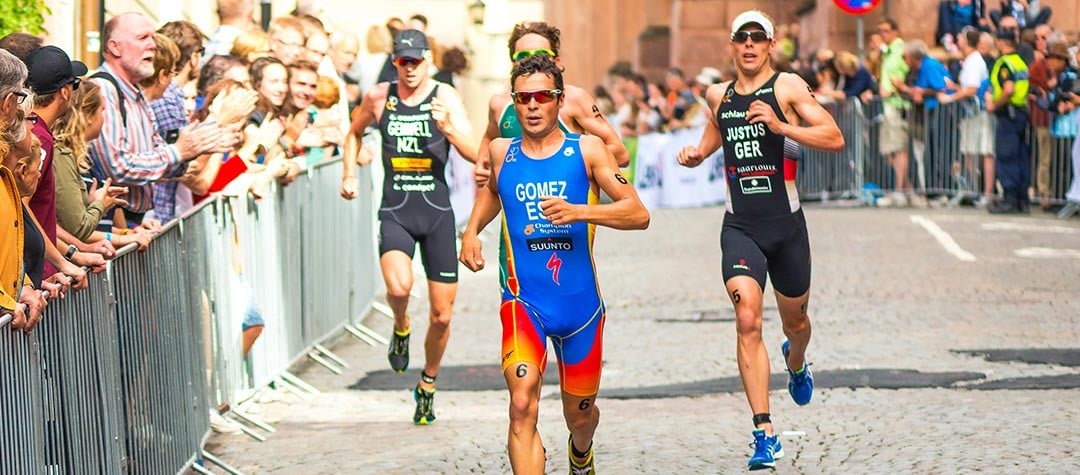How to master the run section of your next triathlon
How you approach the running portion of a triathlon can make or break your race. You might be sabotaging your run without even realising it, so make sure you avoid these five classic triathlon running mistakes.
1. Runner’s tummy
One of the most common running problems in triathlon is having gastrointestinal issues throughout the race. This often causes people so much discomfort that they aren’t able to race to their proper level, and in longer races, it may force an athlete to have to call it a day and duck under the tape.
Figure out what works well for your stomach and practice it in training.
I’m not a nutritionist but I know it’s important to figure out what works well for your stomach and practice it in training. Experiment with any energy gels and sports drinks and see how it feels, then write it down and adapt it until you find a combination that works for you. It’s also good to think about what you’re eating before the race.
I was struggling recently with gastrointestinal problems and kept needing to go to the toilet during races . I couldn’t put my finger on what it was until I spoke to Marco Albert and he said he only ever eats meals with a maximum of two ingredients before a race and never fruit or veg. I realised that my problem was that while I was in the USA I was struggling to get hold of good quality food so, after lots of pizza and pasta meals, I felt like I needed a health boost. This meant I’d attack a huge fruit salad from the shop, not realising it was going straight through me!
2. Get the pace right
It’s very hard and not every athlete will be able to do it, but you should aim to negative split running races whenever possible. This means the back half of your run is as fast or even quicker than the front half.
Running too fast in the first part of the run might make you feel good because you’re doing well. However, it’s slowly but surely taking the sting out of you for the last half of the race and that’s when you want to be able to do the damage.
It’s important not to burn yourself out and be on your knees, losing way more time then you gained in the beginning. Imagine the confidence you’ll be racing with if you’re able to pick off a heap of people when they’re all getting tired. You will probably find it hard to do this but if you go off at a sensible pace to start with, when you start getting tired you’ll lose much less time.
3. Don’t attack the hills
A classic club level running mistake is attacking the hills, and you often see it at cross country races where the team captains and coaches are egging on the athletes to inject this almighty surge! I can’t really think of many reasons why this is a sensible move.
Attacking a hill will quickly put you in oxygen debt and completely numb your legs.
Attacking a hill will quickly put you in oxygen debt and completely numb your legs. What this does is it makes you more tired for the flat sections of the course and that will make it very difficult to get rolling again when you get over the crest. I think you’re far better off reining in your effort on the hills and saving that energy for the flat and downhill parts where you can really make up some time.
I guess the only scenario where you might want to inject some pace on a hill is if you’re leading the race and you want to put your rivals under pressure. That said, you have to be very strong to race in this way and in a triathlon you’re better off going for the best speed you can average throughout to get to the finish line quicker!
4. Mind games
Most triathlon events are quite long and the longer they get, the more they become a mental game as well as physical. As you approach the final few kilometres try to fend off that little voice in your head that keeps telling you that you need to back down and that you’re not as strong as the people around you.
More than likely if the athletes you're running with could drop you then they would have already done so earlier on. Keep the positivity in the head and back yourself to win! This is another reason why you should always know the course, how many laps you need to do etc, because you need to be able to strategise to be successful. You’ll always be much prouder of yourself at the end if you can go to that extra level.
5. Happy feet make a happy racer
This may seem like a small and fairly insignificant tip but footwear can really make or break a race. Everyone knows that you need to have a pair of shoes that fit comfortably and should ideally be lightweight to race in and unless you have leather feet, you should always wear socks for long distance races.
This year at the World 70.3 Champs I was pretty surprised to see I think everyone in the top 20 wearing socks. For the 10 seconds or so it takes to put them on, you will save a lot more time by not stopping/altering your foot strike or shifting around in your shoes.
When racing Sprint and Olympic distance I think it doesn’t make as much sense but if you’re someone who gets sore feet, then it is worth considering. My other tip is when you pour water over yourself during a race to cool down, try to keep it on your head and shoulders and as little as possible on your body. Water running down your legs and into your shoes is the biggest cause of blisters!
Picture credit: Stefan Holm / Shutterstock.com















